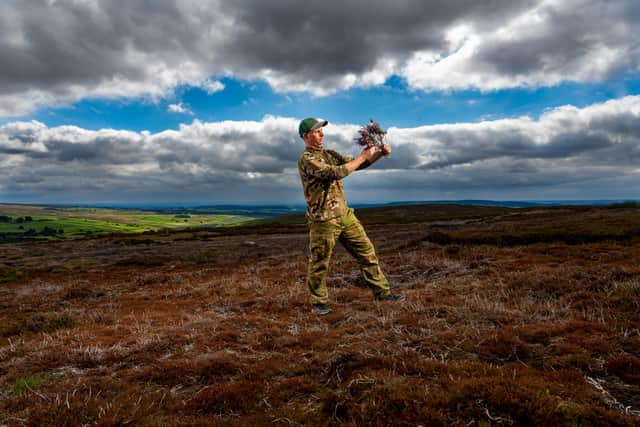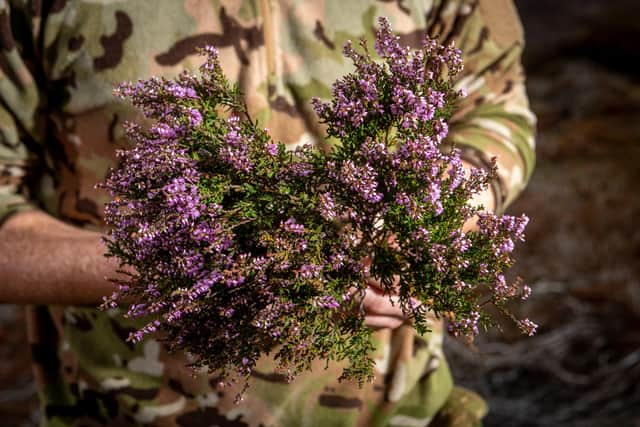‘Biblical’ plague of insects threatens Glorious Twelfth
Swarms of heather beetle are said to have killed off vast swathes of moorland, turning it from the bright purple usual at this time of year, to a dull ginger.
It is the second successive year that the Glorious Twelfth of August, the traditional start of the shooting season, has been blighted by infestation. But the extent this time is far worse, said Luke Wilkinson, who manages an estate in North Yorkshire.
Advertisement
Hide AdAdvertisement
Hide Ad“The numbers are just biblical. It’s a natural disaster – that’s the only way to describe it,” he said.


Mark Osborne, a land agent who manages several moors across the North, estimated that up to three-quarters of shoots planned for the North York Moors would have to be cancelled, with around a third of those in lesser affected areas like the Yorkshire Dales also hit.
He said: “Heather beetle has always been about but until a few years ago it was on a small scale and very localised. Since then the scale has grown unbelievably.
“The North York Moors had a particularly dry spring, which is why it’s worse there. Last year about a third of the area was affected – this year it’s more like 70 per cent, in varying degrees.”
Advertisement
Hide AdAdvertisement
Hide AdYounger plants were most likely to be wiped out by the insects, he said, with some stronger ones capable of recovering next year.


The insects which reproduced on the moors were later carried east on the wind and were eventually washed up on beaches around Whitby, where they were said to be several inches thick.
“There were literally millions of them on the beach,” Mr Osborne said. “But they were dead by then. The worry is that the moors have got a mass of larvae now that will hatch next spring. And if those carry on drifting on the moors then we will possibly lose the whole of the rest of the heather moorland.”
He said that despite official guidance to restrict the burning of heather in order to protect the habitat of breeding birds and other species, setting light to the plants was “absolutely essential”.
Advertisement
Hide AdAdvertisement
Hide AdHowever, the Government has been urging landowners to adopt “sustainable” alternatives to the controversial practice of setting heather-covered moorland on fire to create more attractive habitats for grouse. It says burning does not necessarily eradicate the beetles and that infected heather is likely to recover by itself over a five year period.
An environment department spokesman said: “The Government has always been clear of the need to phase out rotational burning of protected blanket bog to conserve these vulnerable habitats. We are looking at how legislation could achieve this.”
But Amanda Anderson, director of the Moorland Association, said controlled heather burning was “one of the main tools we have” to regenerate moorland. The dead plants also increased the risk of wildfires, she added.
“The problem has been compounded this year by the drought earlier in the summer,” Ms Anderson said. “This can all be linked in to the effects of climate change and that’s why it’s so important to build in as much resilience to the moors.”
Advertisement
Hide AdAdvertisement
Hide AdShe said the beetles washed up on the beaches earlier in the year were an indicator of a drastic shift in their population.
“Heather beetle attack is very significant and increasing problem on moors and heaths across Britain and will have a major impact on shoots getting going early in the season,” she said.
• The start of the grouse shooting season will go ahead on Wednesday with gamekeepers in visors and face masks and beaters practicing social distancing, the Moorland Association has said.
Shooting is estimated to be worth £2bn to the nation’s economy, and Gary Taylor, head keeper at the Swinton Estate, near Ripon, said: “It’s vitally important for rural communities in some of our most remote areas that the economy opens up as quickly as it can. But we can only do that successfully, if all the right safety measures are in place.
Advertisement
Hide AdAdvertisement
Hide Ad“It does feel a bit unreal but all businesses, whether they are in towns or the countryside, have had to adapt.”
Amanda Anderson, director of the Moorland Association, said: “People running all kinds of rural businesses are acutely aware of the need to strike the right balance between trying to reinvigorate the economy as well as keeping everyone safe.”
Editor’s note: first and foremost - and rarely have I written down these words with more sincerity - I hope this finds you well.
Almost certainly you are here because you value the quality and the integrity of the journalism produced by The Yorkshire Post’s journalists - almost all of which live alongside you in Yorkshire, spending the wages they earn with Yorkshire businesses - who last year took this title to the industry watchdog’s Most Trusted Newspaper in Britain accolade.
Advertisement
Hide AdAdvertisement
Hide AdAnd that is why I must make an urgent request of you: as advertising revenue declines, your support becomes evermore crucial to the maintenance of the journalistic standards expected of The Yorkshire Post. If you can, safely, please buy a paper or take up a subscription. We want to continue to make you proud of Yorkshire’s National Newspaper but we are going to need your help.
Postal subscription copies can be ordered by calling 0330 4030066 or by emailing [email protected]. Vouchers, to be exchanged at retail sales outlets - our newsagents need you, too - can be subscribed to by contacting subscriptions on 0330 1235950 or by visiting www.localsubsplus.co.uk where you should select The Yorkshire Post from the list of titles available.
If you want to help right now, download our tablet app from the App / Play Stores. Every contribution you make helps to provide this county with the best regional journalism in the country.
Sincerely. Thank you.
James Mitchinson, Editor
Comment Guidelines
National World encourages reader discussion on our stories. User feedback, insights and back-and-forth exchanges add a rich layer of context to reporting. Please review our Community Guidelines before commenting.